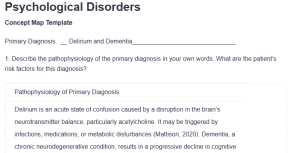Psychological Disorders
Concept Map Template
Primary Diagnosis: __ Delirium and Dementia______________________________
- Describe the pathophysiology of the primary diagnosis in your own words. What are the patient’s risk factors for this diagnosis?
| Pathophysiology of Primary Diagnosis | |
| Delirium is an acute state of confusion caused by a disruption in the brain’s neurotransmitter balance, particularly acetylcholine. It may be triggered by infections, medications, or metabolic disturbances (Mattison, 2020). Dementia, a chronic neurodegenerative condition, results in a progressive decline in cognitive function, as noted by Błaszczyk (2022). Amyloid plaques and neurofibrillary tangles, which harm neurons and synapses and cause cognitive impairment over time, are linked to Alzheimer’s disease, the most prevalent type of dementia. | |
| Causes | Risk Factors (genetic/ethnic/physical) |
| Delirium can result from acute illness, drug withdrawal, or surgery (Mattison, 2020). Dementia is often caused by Alzheimer’s disease, vascular problems, or other neurodegenerative conditions. | Delirium: Advanced age, surgery, infection, dehydration.
Dementia: Aging, genetic predisposition, hypertension, diabetes. |
- What are the patient’s signs and symptoms for this diagnosis? How does the diagnosis impact other body systems and what are the possible complications?
| Signs and Symptoms – Common presentation | How does the diagnosis impact each body system? Complications? |
| Distinctive signs and symptoms of Delirium include abrupt onset of confusion, inattention, hallucinations, agitation, or lethargy.
Typical presentations of Dementia include gradual memory loss, difficulty with language, disorientation, and personality changes. |
Delirium can affect the cardiovascular system (e.g., tachycardia), exacerbate immobility, and lead to prolonged hospital stays (Mattison, 2020).
Dementia can cause motor impairments, incontinence, and difficulty swallowing, leading to malnutrition, pneumonia, or falls. |
- What are other potential diagnoses that present in a similar way to this diagnosis (differentials)?
| While they vary in onset and length, similar illnesses that can present include depression, schizophrenia, or stroke and may result in cognitive or behavioral problems. |
- What diagnostic tests or labs would you order to rule out the differentials for this patient or confirm the primary diagnosis?
| Cognitive assessments, metabolic panel, and urinalysis to rule out underlying causes for the case of Delirium.
Dementia: Mini-Mental State Examination, MRI, or CT scans to assess brain atrophy and cerebrospinal fluid analysis for biomarkers (Arvanitakis et al., 2019). |
- What treatment options would you consider? Include possible referrals and medications.
| Delirium: Treat underlying causes (e.g., infection), environmental modifications, and antipsychotics in some cases.
Dementia: Cholinesterase inhibitors (e.g., donepezil), memantine for symptom management, referrals to neurologists or geriatric specialists, and support for caregivers as asserted by Arvanitakis et al. (2019). |
References
Arvanitakis, Z., Shah, R. C., & Bennett, D. A. (2019). Diagnosis and Management of Dementia: Review. Jama, 322(16), 1589–1599. https://doi.org/10.1001/jama.2019.4782
Błaszczyk, J. W. (2022). Pathogenesis of Dementia. International Journal of Molecular Sciences, 24(1), 543. https://doi.org/10.3390/ijms24010543
Mattison, M. L. P. (2020). Delirium. Annals of Internal Medicine, 173(7), ITC49–ITC64. https://doi.org/10.7326/aitc202010060
ORDER A PLAGIARISM-FREE PAPER HERE
We’ll write everything from scratch
Question
Concept Map Template
Primary Diagnosis: ___________________________________________________________
- Describe the pathophysiology of the primary diagnosis in your own words. What are the patient’s risk factors for this diagnosis?
| Pathophysiology of Primary Diagnosis | |
| Causes | Risk Factors (genetic/ethnic/physical) |

Psychological Disorders
- What are the patient’s signs and symptoms for this diagnosis? How does the diagnosis impact other body systems and what are the possible complications?
| Signs and Symptoms – Common presentation | How does the diagnosis impact each body system? Complications? |
- What are other potential diagnosis that present in a similar way to this diagnosis (differentials)?
- What diagnostic tests or labs would you order to rule out the differentials for this patient or confirm the primary diagnosis?
- What treatment options would you consider? Include possible referrals and medications.

